 W
WThe flightless cormorant, also known as the Galapagos cormorant, is a cormorant endemic to the Galapagos Islands, and an example of the highly unusual fauna there. It is unique in that it is the only known cormorant that has lost the ability to fly. Once it was placed in its own genus, Nannopterum, although current taxonomy places it in the genus with most of the other cormorants, Phalacrocorax.
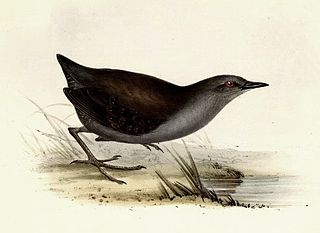 W
WThe Galapagos crake or Galapagos rail is a small rail endemic to the Galapagos Islands. It resembles its sister species, the black rail of The Americas, from which it diverged 1.2 million years ago. It is threatened by introduced species, such as goats and cats, and is considered vulnerable.
 W
WDarwin's finches are a group of about 18 species of passerine birds. They are well known for their remarkable diversity in beak form and function. They are often classified as the subfamily Geospizinae or tribe Geospizini. They belong to the tanager family and are not closely related to the true finches. The closest known relative of the Galápagos finches is the South American Tiaris obscurus. They were first collected by Charles Darwin on the Galápagos Islands during the second voyage of the Beagle. Apart from the Cocos finch, which is from Cocos Island, the others are found only on the Galápagos Islands.
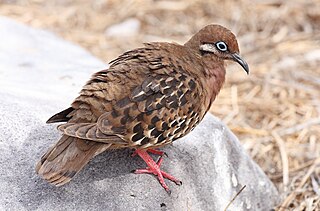 W
WThe Galápagos dove is a species of bird in the family Columbidae. It is endemic to the Galápagos, off Ecuador. It is fairly common and is found in a wide range of open and semi-open habitats, especially in the arid lowlands of the archipelago.
 W
WThe common cactus finch or small cactus finch is a species of bird in the Darwin's finch group of the tanager family Thraupidae. It is endemic to the Galapagos Islands, where it is found on most islands, with the notable exception of Fernandina, Española, Genovesa, Darwin and Wolf. Most of these islands are inhabited by its close relative, the Española cactus finch.
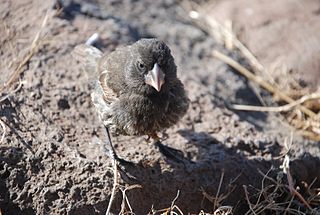 W
WThe Española cactus finch, is a species of bird in the tanager family Thraupidae. It is one of Darwin's finches, and is endemic to the Galápagos islands, where it is restricted to Española, Genovesa, Darwin and Wolf Islands. This rather dark bird resembles the smaller and finer-beaked common cactus finch, but the two species do not co-inhabit any island.
 W
WThe Genovesa cactus finch is a species of bird in the tanager family Thraupidae. It is one of Darwin's finches, and is endemic to the Galápagos islands, Ecuador, where it is restricted to Genovesa Island.
 W
WThe Genovesa ground finch is a small bird native to the Galápagos Islands. It was considered a subspecies of the sharp-beaked ground finch endemic to Genovesa Islands. The International Ornithologists' Union has split the species. Other taxonomic authorities still consider it conspecific.
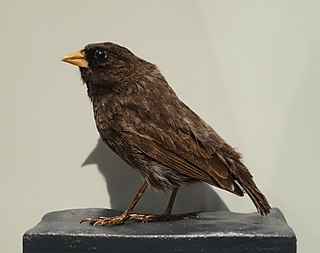 W
WThe sharp-beaked ground finch is a species of bird in the Darwin's finch group of the tanager family Thraupidae. It is classified as a least-concern species by the International Union for Conservation of Nature and it is native to the Galápagos Islands in Ecuador. It has a mass of around 20 grams (0.71 oz) and the males have black plumage, while females have streaked brown plumage. This finch was described by Richard Bowdler Sharpe in 1888.
 W
WThe vampire ground finch is a small bird native to the Galápagos Islands. It was considered a very distinct subspecies of the sharp-beaked ground finch endemic to Wolf and Darwin Islands. The International Ornithologists' Union has split the species supported by strong genetic evidence that they are not closely related, and divergences in morphology and song. Other taxonomic authorities still consider it conspecific.
 W
WThe large ground finch is a species of bird. One of Darwin's finches, it is now placed in the family Thraupidae and was formerly in the Emberizidae. It is endemic to the Galapagos Islands, and is found in the arid zone of most of the archipelago, though it is absent from the southeastern islands. It is the largest species of Darwin's finch both in total size and size of beak. It has a large, short beak for cracking nuts to get food.
 W
WThe mangrove finch is a species of bird in the Darwin's finch group of the tanager family Thraupidae. It is endemic to the Galápagos Islands. It was found on the islands of Fernandina and Isabela, but recent surveys have failed to record the species on Fernandina. It has been classified as critically endangered by BirdLife International, with an estimated population of between 60 and 140 located in two large mangroves on Isabela. A study has shown that the two small populations remaining on Isabela Island have begun undergoing speciation and that one or both populations will eventually become extinct due to a lack of interbreeding.
 W
WThe medium ground finch is a species of bird in the family Thraupidae. It is endemic to the Galapagos Islands. Its natural habitats are subtropical or tropical dry forests and subtropical or tropical dry shrubland. One of Darwin's finches, the species was the first which scientists have observed evolving in real-time.
 W
WThe small ground finch is a species of bird in the tanager family Thraupidae. Endemic to the Galápagos Islands, it is common and widespread in shrubland, woodland, and other habitats on most islands in the archipelago. It commonly feeds on small seeds and parasites from the skins of Galápagos land and marine iguanas and Galápagos tortoises.
 W
WThe small tree finch is a species of bird in the Darwin's finch group of the tanager family Thraupidae. It is endemic to the Galapagos Islands.
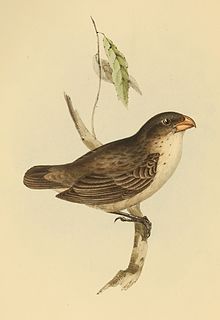 W
WThe large tree finch is a species of bird in the Darwin's finch group of the tanager family Thraupidae. It is endemic to the Galapagos Islands.
 W
WThe medium tree finch is a critically endangered species of bird in the Darwin's finch group of the tanager family Thraupidae. It is endemic to the Galápagos Islands where it is only found on Floreana Island. Its name is derived from the fact that the bird's beak is intermediate in size between that of the small tree finch and the large tree finch. Because it has a very small range on a single island, and because of the introduction of a parasitic fly which kills the nestlings, the International Union for Conservation of Nature has rated the medium tree finch as "critically endangered".
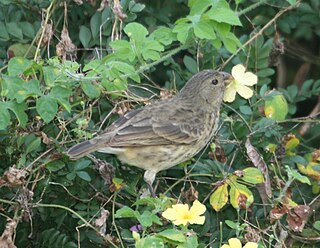 W
WThe vegetarian finch is a species of bird in the Darwin's finch group of the tanager family Thraupidae. It is the only member of the genus Platyspiza. It is endemic to the Galápagos Islands. Its natural habitats are subtropical or tropical dry forests and subtropical or tropical moist montane forests.
 W
WThe woodpecker finch is a monomorphic species of bird in the Darwin's finch group of the tanager family, Thraupidae. They are a non-migratory species and are endemic to the Galapagos Islands. The diet of a woodpecker finch revolves mostly around invertebrates, but also encompasses a variety of seeds. Woodpecker finches, like many other species of birds, form breeding pairs and care for young until they have fledged. The most distinctive characteristic of woodpecker finches is their ability to use tools to for foraging. This behaviour indicates that they have highly specialized cognitive abilities. Woodpecker finches have also shown the ability to learn new behaviours regarding tool use via social learning. Not all populations of woodpecker finches use tools equally as often, as this is influenced by the environment in which they live.
 W
WThe Galápagos flycatcher also known as the large-billed flycatcher is a species of bird in the family Tyrannidae. It is endemic to the Galápagos Islands, where it is present on all the main islands. Its local name is 'Papamoscas'. The species was once placed in its own genus, Eribates, based upon a supposed "very long tarsus".
 W
WThe lava gull, also known as the dusky gull, is a medium-sized gull and a member of the "hooded gull" group. It is most closely related to the Laughing gull and Franklin's gull and is the rarest gull in the world. It is endemic to the Galapagos Islands.
 W
WThe Galapagos hawk is a large hawk endemic to most of the Galapagos Islands.
 W
WThe lava heron, also known as the Galápagos heron, is a species of heron endemic to the Galápagos Islands of Ecuador. It is considered by some authorities — including the American Ornithological Society and BirdLife International — to be a subspecies of the striated heron, and was formerly "lumped" with this species and the green heron as the green-backed heron.
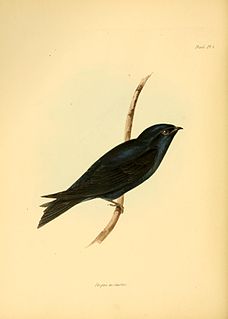 W
WThe Galápagos martin is a species of bird in the family Hirundinidae, endemic to the Galápagos Islands.
 W
WThe Floreana mockingbird or the Charles Island mockingbird, is a species of bird in the family Mimidae.
 W
WThe Galápagos mockingbird is a species of bird in the family Mimidae. It is endemic to the Galápagos Islands, Ecuador.
 W
WThe Hood mockingbird, also known as the Española mockingbird, is a species of bird in the family Mimidae. It is endemic to Española Island in the Galápagos Islands, Ecuador, and it is one of four closely related mockingbird species endemic to the Galápagos archipelago. It is found in dry forests and is omnivorous, though it primarily is a carnivore or scavenger. The species has a highly territorial social structure and has no fear of humans. It is the only species of Galápagos mockingbird that Charles Darwin did not see or collect on the voyage of the Beagle.
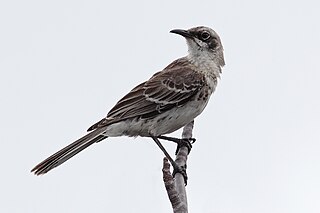 W
WThe San Cristóbal mockingbird or Chatham mockingbird, is a species of bird in the family Mimidae. It is endemic to San Cristóbal Island in the Galápagos Islands.
 W
WThe Galápagos penguin is a penguin endemic to the Galápagos Islands, Ecuador. It is the only penguin found north of the equator. Most inhabit Fernandina Island and the west coast of Isabela Island. The cool waters of the Humboldt and Cromwell Currents allow it to survive despite the tropical latitude. The Galápagos penguin is one of the banded penguins, the other species of which live mostly on the coasts of Africa and mainland South America. It is one of the smallest species of penguin in the world. Because of their warm environment, Galápagos penguins have developed techniques to stay cool. The feathers on their back, flippers, and head are black, and they have a white belly and a stripe looping from their eyes down to their neck and chin. Each penguin keeps only one mate, and breeds year-round. Their nests are typically in caves and crevices as protection against predators and the harsh environment. The Galápagos penguin has a lifespan of about 15 to 20 years, but due to predation, life expectancy in the wild could be significantly reduced.
 W
WThe Galápagos petrel is one of the six endemic seabirds of the Galápagos. Its scientific name derives from Ancient Greek: Pterodroma originates from pteron and dromos, meaning "wing" and "runner", and phaeopygia comes from phaios and pugios, meaning "dusky" and "rump". Members of Pterodroma genus are also called the gadfly petrels because their erratic twisting and turning in flight resemble that of gadflies.
 W
WThe Galápagos shearwater is a small shearwater. Until recently it was considered to be a subspecies of Audubon's shearwater, but it is actually one of two members of a very ancient lineage of the small Puffinus species, the other being, as indicated by mtDNA cytochrome b sequence data, the Christmas shearwater.
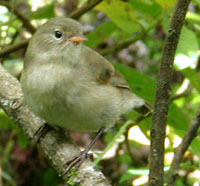 W
WThe green warbler-finch is a species of bird, one of Darwin's finches in the tanager family Thraupidae. Sometimes classified in the family Emberizidae, more recent studies have shown it to belong in the tanager family.
 W
WThe grey warbler-finch is a species of bird, one of Darwin's finches in the tanager family Thraupidae. Sometimes classified in the family Emberizidae, more recent studies have shown it to belong in the tanager family. It is endemic to the Galápagos Islands, Ecuador.